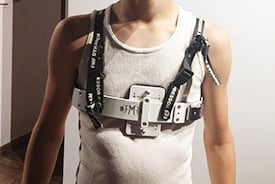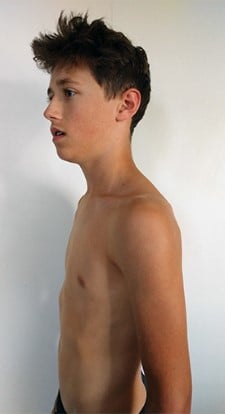Pectus Carinatum: Rogan’s Story
Meet Rogan

What started as “a little bump” in the left center of his chest had slowly grown over time, and Rogan’s local pediatrician suggested surgery as the best option for a more permanent result. After some watchful waiting and additional conversations, Rogan’s parents worked with the doctor to identify the growing bump as pectus carinatum – also known as “pigeon chest” – a deformity that pushes the sternum out.
“I was pretty calm, just because I was pretty sure I knew what was going on,” said Rosalynn Wetta, Rogan’s mother. “I just knew as he gets older, he’s going to have lower self-esteem if his chest is projecting outward and no one else’s is. I knew then we needed to address this now while it’s a minor problem.”
A great attitude goes a long way
At that point, the bump was still small and thankfully not affecting his confidence—and Rogan’s attitude would prove to be his largest asset in the months to come.
“Me and my friends kind of made jokes about it,” Rogan said. “It was weird.”
It wasn’t long before Rogan was on board to take action before the condition worsened.
“Those conversations became very easy once he started noticing it himself and wanted to be part of the solution,” said Jacob Wetta, Rogan’s father. “It’s a testament to who he is and the responsibility that he took to make these changes.”
Nonsurgical treatment: a customized brace
The pediatrician referred the Wetta family to the Center for Pectus Excavatum and Carinatum at Children's Mercy Kansas City to explore a nonsurgical treatment option – a customized brace called the dynamic compression system (DCS) – which has become the standard of care. On the cusp of his 13th birthday, Rogan was in the ideal age range for the treatment (during the time of rapid growth and development).
“The conversation about surgery kind of went to the back burner,” Jacob said, “waiting to see what the team at Children's Mercy had to say and what direction they suggested we go.”
The family made the three-hour drive from their home in Wellington, Kansas, to Children’s Mercy (“I had to wake up really early,” Rogan joked) to get fitted for the brace that would become a constant part of his day for the next couple of months.
Not too noticeable
“At first, it was a little awkward because it was tight on my chest,” he said. “And nobody’s used to that initially. But it took about a week to feel normal.”

So normal, in fact, that Rogan said the brace really didn’t impact his daily routine or typical school activities. Since the brace is worn underneath clothing, is not easily noticeable. Rogan even continued playing football—simply removing the brace before putting on his pads.
And those same friends who joked along with him about the initial bump? They remained unfazed by the new brace they’d see in the locker room, due in large part to how he presented it to them.
“He’s got a really good group of friends,” Jacob added, “so when he first got the brace and had to wear it to school, he just walked in and said, ‘Here it is, guys, this is what I’ve got.’ They all kind of poked at it, understood what it was for, and that was kind of the end of the conversation.”
Commitment yields results
Rogan’s attitude – both toward his condition and the steps to correct it – would lead to even faster results, achieving full correction of his chest within one month of bracing (compared to an average of 5-6 months). The team at Children's Mercy said he deserves a lot of the recognition.
“His compliance was outstanding … and credit goes to him for being committed to the process,” said Tracy Rellihan, OTR/L, an occupational therapist and pectus team member. “We know from experience (and research has shown) the more you wear the brace, the better outcome the patient will achieve.”
Bracing more than 120 new patients each year, the Pectus Center team at Children’s Mercy knows firsthand how important the bracing treatment can be during such a crucial time in a child’s development.
“Pectus carinatum is primarily a cosmetic condition, and although it does not impose any health risks or significant physical symptoms, it is important to address the emotional and psychosocial impact – such as poor body image or low self-esteem that it can cause an adolescent during such an important time during their life,” said Beth Orrick, ARNP, an advanced registered nurse practitioner in the center. "Studies have shown that correcting pectus carinatum with a brace can improve self-image, which is inarguably a positive health outcome."
Dedicated team

Now in maintenance mode, Rogan wears his brace only while sleeping, and his family makes the drive to Children’s Mercy about every eight weeks for minor adjustments. His parents give credit both to the clinical team and to Rogan himself for a successful treatment.
“We all committed early on to walk this journey with Rogan,” Jacob said. “Children’s Mercy has a phenomenal pectus team. They treat everyone as if they’re family and with the utmost care and compassion the minute you walk through that door.”
“We saw results immediately, it was amazing,” Rosalynn added. “Even [Rogan will] be like, ‘Look at my chest, it’s completely flat!’ He’s happy with how he looks.”
Looking back, Rogan said he’s thankful for his decision to move forward with the treatment and encourages other kids to be just as proactive.
“Be open about it … And if you’re just noticing it, go get an opinion as soon as possible—because that’s what we did, and it’s obviously working.”